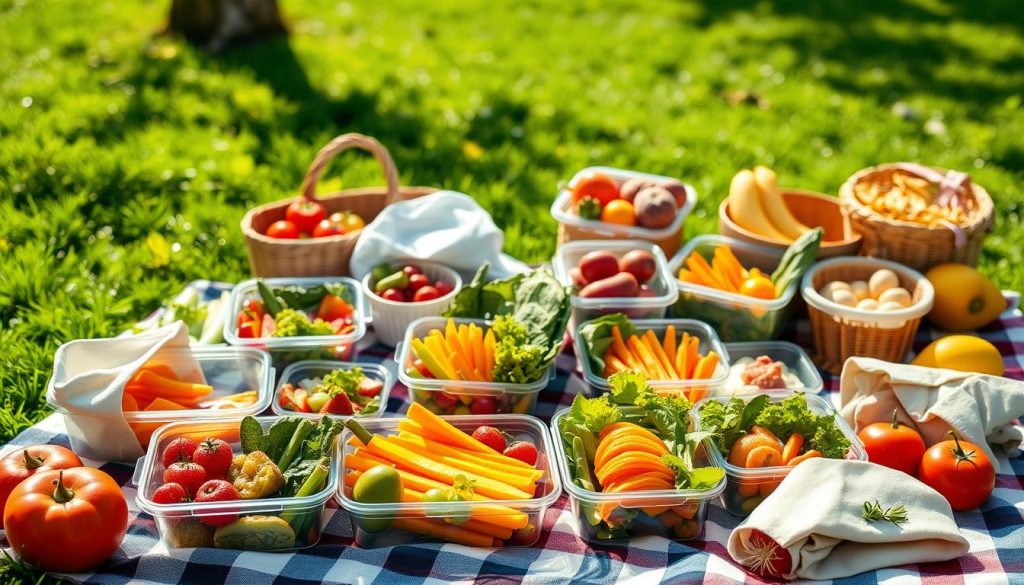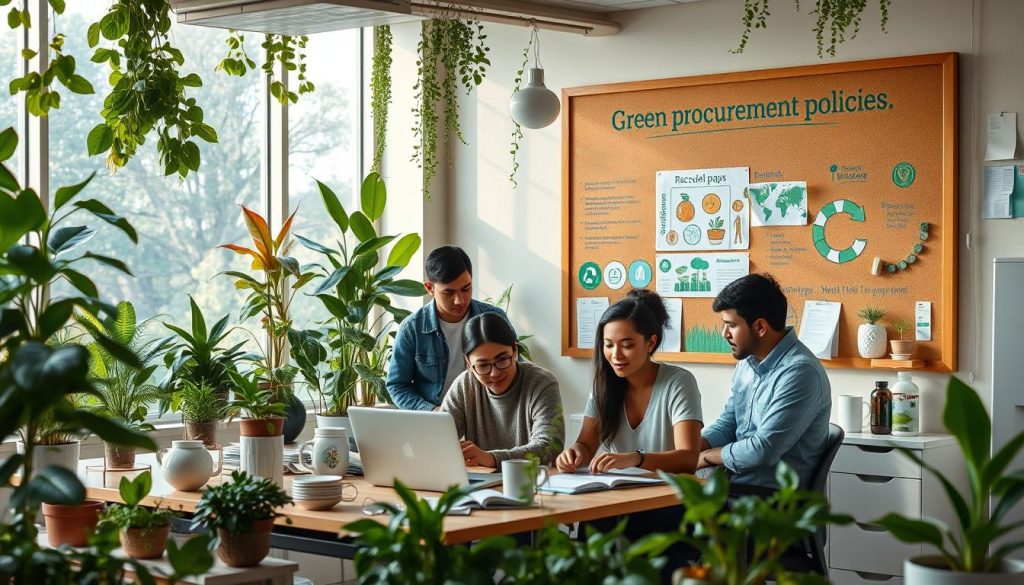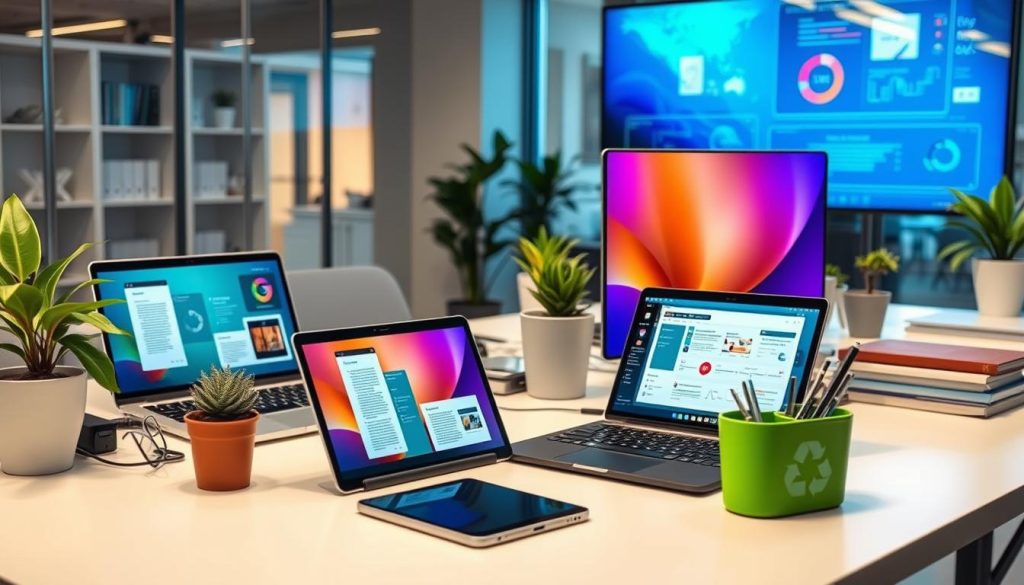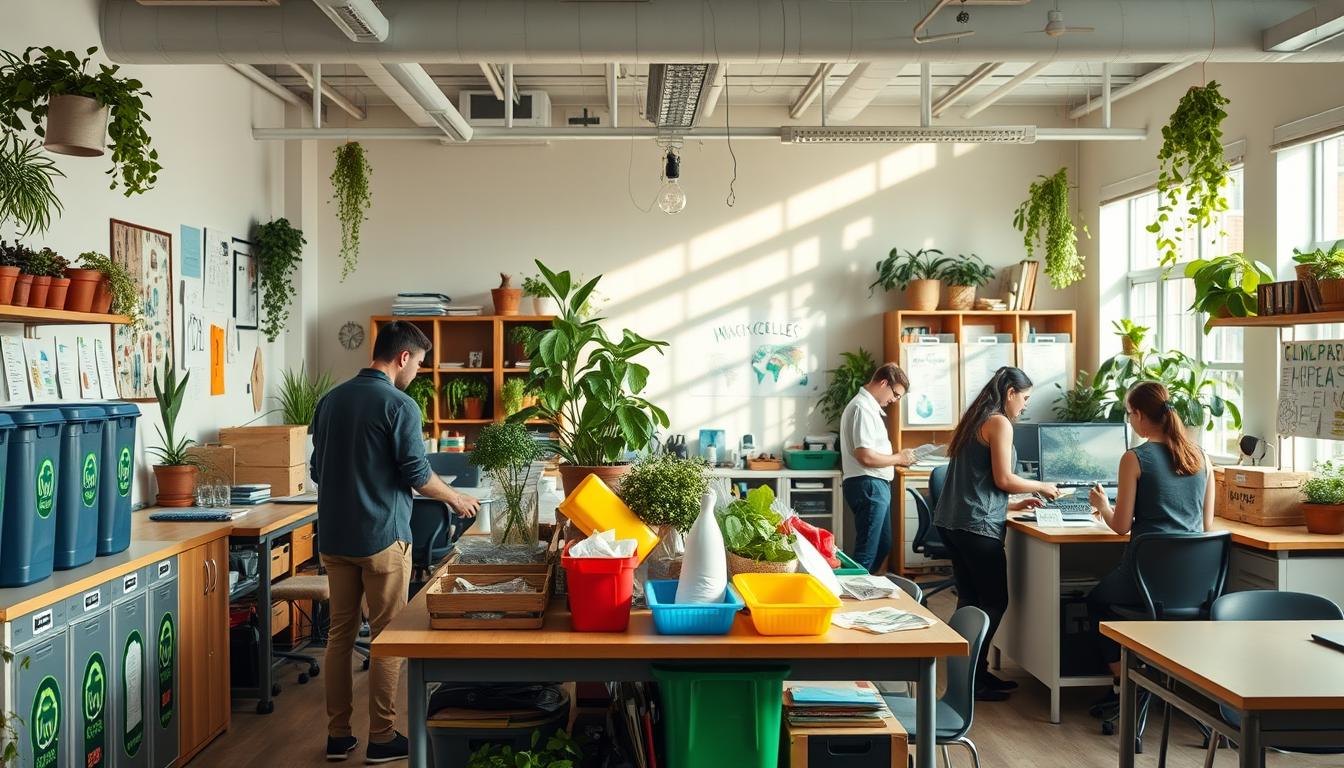I’m excited to share some game-changing ideas about zero waste at work and school. These sustainable practices can make a real difference in our daily lives. From classrooms to offices, we have many chances to cut down on waste and boost our eco-friendly initiatives.
In this guide, I’ll walk you through simple steps to create a greener workspace or learning environment. We’ll explore practical ways to reduce, reuse, and recycle that fit seamlessly into your routine. Let’s dive in and discover how easy it can be to make a positive impact on our planet, one small change at a time.
Understanding the Zero Waste Concept
The zero waste concept is a strong way to cut down on waste. I’ve seen it change workplaces and schools for the better. Let’s explore what it is and why it’s important.
Definition and Principles of Zero Waste
Zero waste means getting rid of all waste by changing how we use resources. It’s about changing how we view materials. The main goal is to send no waste to landfills or incinerators.
Benefits of Implementing Zero Waste Practices
Zero waste practices offer many benefits:
- Less harm to the environment
- Lower costs for waste management
- Better use of resources
- Better image for companies
- More chances to learn about the environment
These perks make zero waste appealing to businesses and schools alike.
Common Challenges in Achieving Zero Waste
Despite the benefits, there are challenges:
- Changing old habits
- Cost of new systems
- Finding substitutes for single-use items
- Ensuring waste is sorted correctly
Beating these obstacles takes dedication and creativity. But, with effort, I’ve seen groups achieve their zero waste goals.
Assessing Current Waste Practices
Understanding our current waste practices is the first step to a zero-waste environment. A detailed waste assessment helps us find areas to improve. It also guides us in conserving resources. Let’s see how to effectively evaluate waste streams.
First, conducting a waste audit is recommended. This means collecting and sorting all waste over a set period. By categorizing items, we can see what types and amounts of waste we produce. This data is key for creating eco-friendly plans.
Then, we should analyze the results to find patterns and chances for reduction. Look for items that can be cut out, reused, or recycled. This step is vital for making focused strategies to reduce waste and save resources.
Here’s a simple table to help track waste assessment findings:
| Waste Type | Amount (lbs/week) | Potential Action |
|---|---|---|
| Paper | 50 | Implement digital systems |
| Plastic bottles | 30 | Install water refill stations |
| Food waste | 75 | Start composting program |
| Electronics | 10 | Partner with e-waste recyclers |
By regularly checking our waste practices, we can see how we’re doing. We can then tweak our eco-friendly plans as needed. This ongoing effort helps us keep improving in saving resources.
Implementing Recycling Programs
Recycling programs are vital for reducing waste. I’ve seen how they make workplaces and schools greener. Let’s look at how to set up good systems and teach our communities.
Setting up effective recycling stations
It’s important to have easy-to-use recycling stations. I put bins in busy spots with clear labels. This helps everyone sort their trash right.
Using bins for paper, plastics, glass, and metals is a good idea. It works well in most places.
Educating staff and students on proper recycling
Teaching about recycling is key. I run workshops and make posters to show how to sort. Regular updates keep everyone involved.
When people learn the right way, they quickly get on board. It’s amazing!
Partnering with local recycling facilities
Working with local recycling centers helps a lot. I take groups on tours to see where our recyclables go. This makes people more eager to recycle.
These partnerships also bring new ideas for better waste management. It’s great to see our community get involved and help the environment.
Reducing Single-Use Plastics

I think it’s key to cut down on single-use plastics in our workplaces and schools. Simple steps can make a big difference for our planet. Let’s look at some ways to cut plastic waste and choose eco-friendly options.
One big change is to encourage plastic-free lunches. We can offer reusable containers and utensils in break rooms and cafeterias. This small action can really cut down on daily plastic waste.
Another good move is to set up water refill stations. This makes it easy to use reusable water bottles instead of plastic ones. I’ve seen it make a big difference in schools and offices.
Here’s a look at single-use plastics and their reusable alternatives:
| Single-Use Item | Reusable Alternative | Environmental Impact |
|---|---|---|
| Plastic water bottles | Stainless steel or glass bottles | Reduces plastic waste by 1,460 bottles per person annually |
| Disposable cutlery | Metal or bamboo utensils | Prevents 300+ plastic utensils from landfills per year |
| Plastic straws | Metal or glass straws | Eliminates 500+ plastic straws per person yearly |
| Plastic lunch bags | Cloth or silicone bags | Saves 180+ plastic bags from waste streams annually |
By choosing these sustainable options, we can make our workplaces and schools greener. Remember, every small change adds up to make a big difference in reducing plastic waste.
Composting Systems for Organic Waste
I’m excited to share how composting systems can change waste management in work and school places. These systems not only cut down on landfill waste. They also make valuable resources for gardening and landscaping.
Benefits of Composting in Work and School Environments
Composting systems have many benefits. They lower waste disposal costs and make soil rich in nutrients for campus gardens. They also teach about natural cycles and sustainability through environmental education.
Setting Up a Composting System
To start a composting system, begin small. Place a few bins in places like cafeterias or break rooms. Choose between indoor worm composting or outdoor tumbling bins based on your space and needs. Make sure there’s good ventilation and a mix of green and brown materials for best results.
Educating Users on Proper Composting Practices
The success of composting systems depends on user involvement. Clear signs and regular workshops are key for teaching. Create guides that explain what can and can’t be composted. Get students involved in monitoring and caring for the compost bins.
| Compostable Items | Non-Compostable Items |
|---|---|
| Fruit and vegetable scraps | Meat and dairy products |
| Coffee grounds and filters | Oily foods |
| Paper napkins and towels | Plastic or metal items |
| Yard trimmings | Diseased plants |
By using these composting systems and focusing on education, we can greatly reduce waste. We can also build a culture of sustainability in our workplaces and schools.
Green Procurement Policies

I think green procurement policies are key for sustainable workplaces and schools. They focus on buying eco-friendly products and services. This helps us reach our zero waste goals and conserve resources.
When I think of green procurement, I look for items made from recycled materials. This reduces waste and supports sustainable practices. For instance, choosing furniture from reclaimed wood or recycled plastic is a big step.
Another important part of green procurement is choosing energy-efficient appliances and electronics. These items cut down on energy use and save money over time. LED lights, ENERGY STAR computers, and smart power strips are good examples.
To make green procurement work, I recommend a checklist for purchases. This checklist should include things like:
- Recyclable or biodegradable packaging
- Non-toxic materials
- Energy efficiency ratings
- Local sourcing to reduce transportation emissions
- Fair trade and ethical production practices
By using this checklist, we can make sure our purchases support our sustainability goals. This helps us conserve resources.
| Traditional Item | Green Alternative | Environmental Benefit |
|---|---|---|
| Disposable pens | Refillable pens | Reduces plastic waste |
| Standard copy paper | Recycled paper | Conserves trees and water |
| Plastic water bottles | Reusable water bottles | Eliminates single-use plastics |
| Chemical cleaners | Eco-friendly cleaners | Reduces harmful chemical use |
Eco-Friendly Office Supplies and School Materials
Choosing eco-friendly office supplies and school materials is crucial for sustainability. It helps us reduce waste and save resources in our work and learning spaces.
- Recycled paper products
- Refillable pens and markers
- Biodegradable pencils
- Solar-powered calculators
- Bamboo desk organizers
These items support resource conservation and encourage others to go green. Using them often leads to discussions about sustainability.
Here’s a comparison of traditional and eco-friendly office supplies to help you choose:
| Product | Traditional Option | Eco-Friendly Alternative | Environmental Impact |
|---|---|---|---|
| Pens | Disposable plastic | Refillable metal | Reduces plastic waste |
| Notebooks | Virgin paper | Recycled paper | Saves trees and energy |
| Highlighters | Plastic with chemical ink | Wooden pencil highlighters | Biodegradable, less toxic |
| Staplers | Metal with plastic | Staple-free staplers | Eliminates metal waste |
By opting for these eco-friendly options, we’re moving towards a greener future in our workplaces and schools.
Digital Solutions for Paper Reduction

Embracing digital solutions is a big step towards reducing waste in offices and schools. Going paperless saves trees and makes our work easier. Let’s look at some ways to use less paper and save resources.
Implementing Paperless Systems
Switching to digital is key for a green office. Digital forms and electronic signatures cut down on printing and filing. They also make finding information quick and easy!
Digital Collaboration Tools
Collaboration tools have changed how we work together. Google Workspace and Microsoft Teams let us edit and share documents in real time. This reduces paper waste and boosts teamwork and productivity.
Electronic Document Management
A good electronic document management system is essential for reducing paper. These systems keep digital documents organized and easy to find. No more digging through file cabinets!
| Paper-Based System | Digital System | Benefits |
|---|---|---|
| Physical storage space | Cloud storage | Saves office space, reduces clutter |
| Manual filing | Automated organization | Saves time, improves efficiency |
| Printed memos | Digital notifications | Instant communication, saves paper |
| Physical signatures | E-signatures | Faster approvals, reduces printing |
By using these digital solutions, we can greatly reduce paper waste. These steps support green office policies and improve work and school environments.
Sustainable Food Practices in Cafeterias and Break Rooms
I’ve seen how cafeterias and break rooms can help the environment. By using eco-friendly ways, we can cut down on waste and eat better. Let’s look at some easy ways to make these spaces greener.
One key step is to have plastic-free lunches. This simple change can greatly reduce plastic waste. Using reusable containers, cutlery, and napkins is a great start. It quickly becomes a habit!
Setting up a composting system for food scraps is another smart move. It reduces landfill waste and makes great soil for gardens. It’s a win for our planet and our gardens.
Here’s a comparison of traditional versus sustainable cafeteria practices:
| Traditional Practices | Sustainable Practices |
|---|---|
| Single-use plastic utensils | Reusable metal utensils |
| Disposable food containers | Compostable or reusable containers |
| Pre-packaged snacks | Bulk snack dispensers |
| Bottled water | Water refill stations |
These sustainable practices are good for the planet and our health. By offering more whole foods and less processed ones, we support healthy eating. This also helps us reach our eco-friendly goals.
Encouraging Reusable Items
One of the best ways to reduce waste is to promote reusable items at work and school. This simple step can greatly help our eco-friendly efforts.
Promoting reusable water bottles and coffee mugs
Giving out branded reusable water bottles and coffee mugs is very effective. It helps cut down on single-use plastics and paper cups. It also brings people together by sharing environmental goals.
Implementing a “bring your own” culture
Encouraging a “bring your own” mindset can change how workplaces and schools operate. Asking people to bring their own utensils, plates, and containers reduces disposable items. This small change can lead to significant waste reduction.
Setting up refill stations
Installing water refill stations has been a big help in promoting reusable items. These stations make it easy for everyone to refill their bottles. It’s a clear sign of our commitment to sustainability and helps us stay on track with our zero waste goals.
